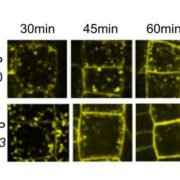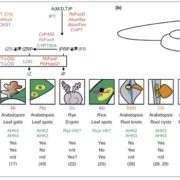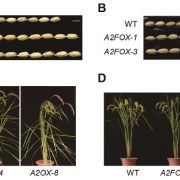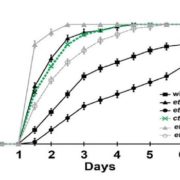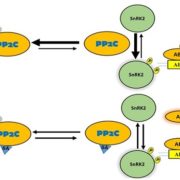Origin and Role of ABA in Stomatal Regulation
 When the vapor pressure difference (VPD) between a leaf and the atmosphere increases (i.e., when air humidity decreases), guard cells lose turgor, thereby leading to stomatal closure. The evolution of this mechanism was an important step in the colonization of land by plants, since it enabled plants to control water loss when they were exposed to a dry atmosphere. However, the mechanism of VPD-induced stomatal closure is still unclear, and the debate about the role of the plant stress hormone abscisic acid (ABA) in this process continues. The response to increased VPD is passive when the stomatal closure results solely from reduced leaf water content and turgor due to stronger evaporative demand in dry air. In lycophytes, ferns, and conifers, it has been shown that VPD-induced stomatal closure is a passive response to reduced leaf turgor with no functional ABA synthesis detected in their leaves. Angiosperms, on the other hand, showed VPD-induced ABA synthesis associated with a rapid up-regulation of 9-cis-epoxycarotenoid dioxygenase (NCED) genes, indicating that an active, ABA-mediated component is involved. Merilo et al. (10.1104/pp.17.00912) show that Arabidopsis lines carrying mutations in different steps of ABA biosynthesis as well as pea (Pisum sativum) wilty and tomato (Solanum lycopersicum) flacca ABA-deficient mutants had higher stomatal conductance compared with wild-type plants. To characterize the role of ABA production in different cells, the authors generated transgenic plants in which ABA biosynthesis was rescued in guard cells or phloem companion cells of an ABA-deficient mutant. In both cases, the whole-plant stomatal conductance, stunted growth phenotype, and leaf ABA level were restored to wild-type values, indicating the redundancy of ABA sources and the effectiveness of leaf ABA transport. All ABA-deficient lines closed their stomata rapidly and extensively in response to high VPD. A strongly ABA-insensitive mutant (aba2-11) responded to changes in VPD in both directions strongly and symmetrically, indicating that its VPD-induced closure is likely to be of the passive hydraulic type.
When the vapor pressure difference (VPD) between a leaf and the atmosphere increases (i.e., when air humidity decreases), guard cells lose turgor, thereby leading to stomatal closure. The evolution of this mechanism was an important step in the colonization of land by plants, since it enabled plants to control water loss when they were exposed to a dry atmosphere. However, the mechanism of VPD-induced stomatal closure is still unclear, and the debate about the role of the plant stress hormone abscisic acid (ABA) in this process continues. The response to increased VPD is passive when the stomatal closure results solely from reduced leaf water content and turgor due to stronger evaporative demand in dry air. In lycophytes, ferns, and conifers, it has been shown that VPD-induced stomatal closure is a passive response to reduced leaf turgor with no functional ABA synthesis detected in their leaves. Angiosperms, on the other hand, showed VPD-induced ABA synthesis associated with a rapid up-regulation of 9-cis-epoxycarotenoid dioxygenase (NCED) genes, indicating that an active, ABA-mediated component is involved. Merilo et al. (10.1104/pp.17.00912) show that Arabidopsis lines carrying mutations in different steps of ABA biosynthesis as well as pea (Pisum sativum) wilty and tomato (Solanum lycopersicum) flacca ABA-deficient mutants had higher stomatal conductance compared with wild-type plants. To characterize the role of ABA production in different cells, the authors generated transgenic plants in which ABA biosynthesis was rescued in guard cells or phloem companion cells of an ABA-deficient mutant. In both cases, the whole-plant stomatal conductance, stunted growth phenotype, and leaf ABA level were restored to wild-type values, indicating the redundancy of ABA sources and the effectiveness of leaf ABA transport. All ABA-deficient lines closed their stomata rapidly and extensively in response to high VPD. A strongly ABA-insensitive mutant (aba2-11) responded to changes in VPD in both directions strongly and symmetrically, indicating that its VPD-induced closure is likely to be of the passive hydraulic type.


